 Amine Treatment Unit - Amine treatment unit uses Methyl Di Ethanol Amine or MDEA to remove H2S and CO2 gases from other lighter hydrocarbon gases. An amine treatment unit involves two stages. First stage is an amine contactor where gases are bought in contact with amine and H2S and CO2 are absorbed in the liquid phase. Second stage is an amine regenerator where H2S and CO2 are stripped away from the liquid phase to regenerate the lean amine solution to be recirculated to the amine contactor column.
Amine Treatment Unit - Amine treatment unit uses Methyl Di Ethanol Amine or MDEA to remove H2S and CO2 gases from other lighter hydrocarbon gases. An amine treatment unit involves two stages. First stage is an amine contactor where gases are bought in contact with amine and H2S and CO2 are absorbed in the liquid phase. Second stage is an amine regenerator where H2S and CO2 are stripped away from the liquid phase to regenerate the lean amine solution to be recirculated to the amine contactor column.
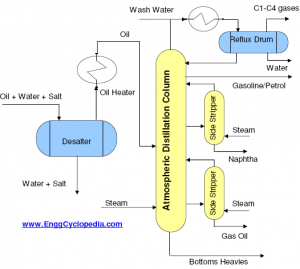 Atmospheric Distillation Unit- Crude oil is sent to the atmospheric distillation unit after desalting and heating. The purpose of atmospheric distillation is primary separation of various ‘cuts’ of hydrocarbons namely, fuel gases, LPG, naptha, kerosene, diesel and fuel oil. The heavy hydrocarbon residue left at the bottom of the atmospheric distillation column is sent to vacuum distillation column for further separation of hydrocarbons under reduced pressure.
Atmospheric Distillation Unit- Crude oil is sent to the atmospheric distillation unit after desalting and heating. The purpose of atmospheric distillation is primary separation of various ‘cuts’ of hydrocarbons namely, fuel gases, LPG, naptha, kerosene, diesel and fuel oil. The heavy hydrocarbon residue left at the bottom of the atmospheric distillation column is sent to vacuum distillation column for further separation of hydrocarbons under reduced pressure.
Crude Oil Refinery: Process Flow - General outline of proces flow in a crude oil refinery, briefly describing following processes in a refinery - crude oil storage, oil desalting, crude oil heaters, atmospheric distillation unit / crude distillation unit and vacuum distillation unit. Crude oil is first stored before being refined. The first step in refining is desalting, followed by heating before sending to atmospheric distillation unit. Heavy bottoms from Atmospheric Distillation is further refined in a Vacuum Distillation unit.
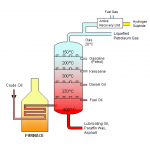 Crude Oil Refining: Products - Brief description of the important products of crude oil refining including - LPG, Petrol / Gasoline, Jet fuel / Kerosene, Diesel, Fuel Oil, Bitumen, Sulphur, Fuel Gas etc.
Crude Oil Refining: Products - Brief description of the important products of crude oil refining including - LPG, Petrol / Gasoline, Jet fuel / Kerosene, Diesel, Fuel Oil, Bitumen, Sulphur, Fuel Gas etc.
Flare System Types - Flare systems are used in process industry are used for collectoing flammable gases and to combust them before releasing to atmosphere. Following types of flare systems are discussed - Open / Elevated flare systems, Enclosed / Ground flare systems, Thermal Oxidizer flare systems.
Naphtha - Naphtha is a common term used to identify cyclic hydrocarbon compound separated from crude oil at the atmospheric distillation unit. Naphthas occur between the gases separated at the top of atmospheric distillation column and kerosene separated somewhere in the middle.
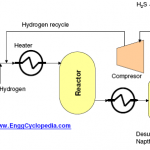 Naphtha Hydrotreating Unit - Heavy Naphtha cut from the atmospheric crude oil distillation column in a refinery is sent to a ‘Naphtha Hydrotreater Unit’. After the hydrotreater unit, naphtha is sent to an isomerisation unit or a catalytic reformer unit, which often use reforming catalysts. Most reforming catalysts contain platinum as the active material. Sulfur and nitrogen compounds present in naphtha cut from atmospheric distillation column can deactivate the catalyst and must be removed prior to catalytic reforming. Purpose of the hydrotreater unit is to remove before the naphtha cut goes to catalytic reformer.
Naphtha Hydrotreating Unit - Heavy Naphtha cut from the atmospheric crude oil distillation column in a refinery is sent to a ‘Naphtha Hydrotreater Unit’. After the hydrotreater unit, naphtha is sent to an isomerisation unit or a catalytic reformer unit, which often use reforming catalysts. Most reforming catalysts contain platinum as the active material. Sulfur and nitrogen compounds present in naphtha cut from atmospheric distillation column can deactivate the catalyst and must be removed prior to catalytic reforming. Purpose of the hydrotreater unit is to remove before the naphtha cut goes to catalytic reformer.
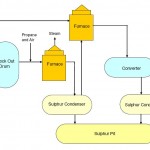 Sulphur Recovery Unit- The basic process used in SRU is ‘Claus Process’ which involves combustion of a part of H2S gas to form SO2. Later this SO2 is reacted (conversion) with H2S in presence of catalyst (Cobalt / molybdenum / aluminum oxide ) to form elemental sulphur and steam.
Sulphur Recovery Unit- The basic process used in SRU is ‘Claus Process’ which involves combustion of a part of H2S gas to form SO2. Later this SO2 is reacted (conversion) with H2S in presence of catalyst (Cobalt / molybdenum / aluminum oxide ) to form elemental sulphur and steam.
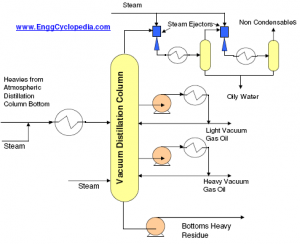 Vacuum Distillation Unit - Heavies from the atmospheric distillation column are heated to approximately 400˚C in a fired heater and fed to the vacuum distillation column where they are fractionated into light gas oil, heavy gas oil and vacuum reside. A typical process flow diagram (PFD) of such a vacuum distillation column is presented. Light vacuum gas Oil is sent to a hydrotreater and then to a ‘catalytic cracking’ unit to obtain smaller chain hydrocarbons. Heavy vacuum gas oil is also sent for cracking using hydrogen in a ‘hydrocracking unit’ to produce smaller chain hydrocarbons.
Vacuum Distillation Unit - Heavies from the atmospheric distillation column are heated to approximately 400˚C in a fired heater and fed to the vacuum distillation column where they are fractionated into light gas oil, heavy gas oil and vacuum reside. A typical process flow diagram (PFD) of such a vacuum distillation column is presented. Light vacuum gas Oil is sent to a hydrotreater and then to a ‘catalytic cracking’ unit to obtain smaller chain hydrocarbons. Heavy vacuum gas oil is also sent for cracking using hydrogen in a ‘hydrocracking unit’ to produce smaller chain hydrocarbons.